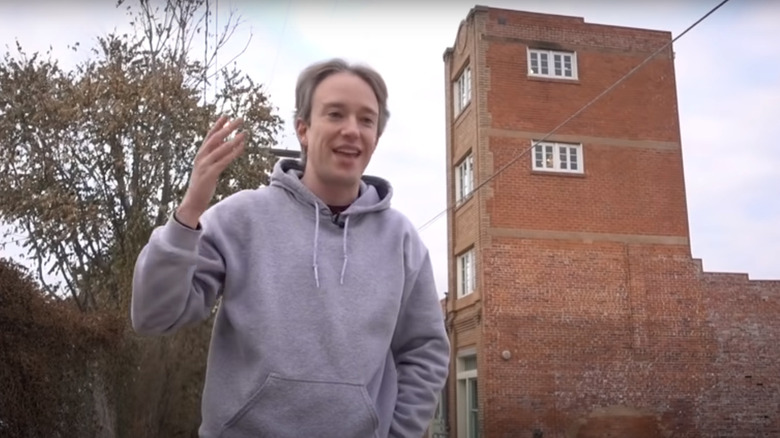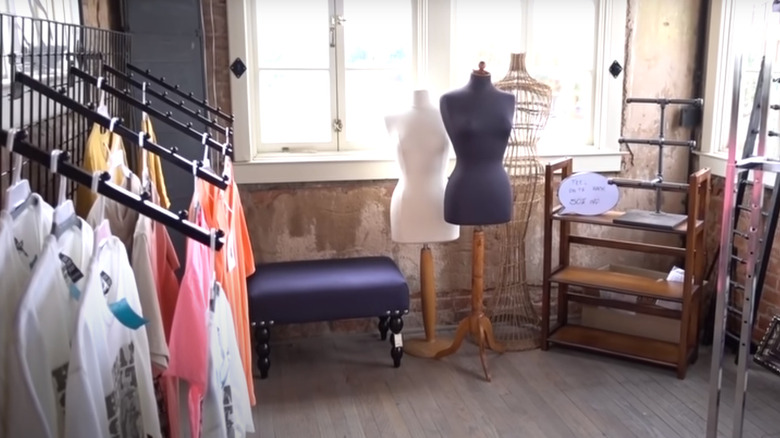How A Con Man Scammed A Texas Town Into Building 'The World's Littlest Skyscraper'
It goes without saying that, by necessity, skyscrapers are built in big cities and/or their suburbs. That's where the tenants are. Sure, you could build one in a small town in the middle of nowhere, but if no one is going to purchase or lease space in it, then you've erected a building that's going to sit empty before it's eventually torn down.
A century ago, it looked like the town of Wichita Falls, Texas was on pace to become the next big city, after oil was discovered nearby, as the Texas State Historical Association reports. Amid all of this newfound wealth and prosperity, a con man rolled through town with promises to build a skyscraper in the community that, a year before, had barely qualified for putting ink on a map. Unfortunately, the townsfolk failed to read the fine print, and before long, they were left with a (mostly) unusable building that was taller than it was wide, like skyscrapers should be, but at a modest 40 feet tall, it was hardly a skyscraper. Further still, it was so narrow that no one wanted to lease space in it, and it sat derelict for decades. Fortunately, of late the town has leaned into its quirky place in architectural history, preserved and restored the building, and now proudly boasts that it's the home of the World's Littlest Skyscraper.
Black gold, Texas tea
Today, Wichita Falls, Texas has a population of around 107,000 or so, according to World Population Review. That makes it less than a major city (at least, in the U.S.), but it's no tiny hamlet, either. However, at the turn of the century, Wichita Falls wasn't even a stop on the road, with a population of about 2,500, according to Texas Almanac. So what accounts for the explosive growth in the town over the course of a century? Oil, of course.
When oil was struck nearby, suddenly the town was the next big thing. Residents became millionaires overnight, and soon enough, the town was a hub of business activity. Unfortunately, as Texas Coop Power explains, the town didn't have the infrastructure to support all of this new commerce, and deals were being struck in tents and on street corners. The town needed office space, and needed it yesterday. That's when J.D. McMahon of Philadelphia showed up with blueprints and big promises.
J.D. McMahon promises to save the day
At this point, the narrative goes from documented historical fact to something that exists somewhere between truth and legend. This all happened a century ago, record-keeping was haphazard, and plenty of the people involved lost face and/or money. As such, parts of the story of the Newby–McMahon Building are based less on documented fact and more on speculation and local lore, according to the Austin Chronicle. But in the main, it goes like this:
McMahon turned up in Wichita Falls in 1919 with blueprints for a multi-story office building, which would go up on a busy downtown intersection across the street from a hotel. He needed investors, however, and soon enough he'd raised about $200,000, according to Texas Coop Power – about $3 million in 2022 dollars, according to Inflation Calculator. Before long, builders were putting hammer to nail, and the building was going up. And by the time anyone realized that something was amiss, it was too late.
Failure to read the fine print
In the U.S., we express feet and inches like this: if someone is, say, five feet, six inches tall, in shorthand we express it as 5'6". Of course, you're reading those punctuation marks as pixels on a screen, not ink on paper. But if they were on paper, the difference between one and the other would amount to an infinitesimally small fraction of an ounce of ink.
Local lore around Wichita Falls has it that McMahon's blueprints for his "skyscraper" expressed everything in inches — " — rather than feet — ' –, as the Austin Chronicle explains. The difference between one punctuation mark and two — the difference between, say, .00003 of an ounce of ink and .00006 of an ounce of ink — resulted in a building not 480 feet tall, but 480 inches tall — about 40 feet. Its width was not 120 feet, but 120 inches, or 10 feet. Its depth was not 192 feet, but 192 inches, or 16 feet.
Tall though it was, such a narrow building wouldn't work for occupancy, to say nothing of the fact that the stairs alone took up one quarter of the floor space, according to Texas Coop Power (which gives slightly different dimensions for the building than the Austin Chronicle). The town was left with a useless "skyscraper," and the builder had skipped town.
What now?
When the dust had settled, the people of Wichita Falls were stuck with a building that no one could use and with the bill. Legend has it that the defrauded investors tried to get their money back, but there was nothing they could do: the builder had built the building exactly according to the plans he'd given to his investors, said a judge, as Texas Coop Power explains. A few tenants did manage to somehow squeeze into the tiny building and conduct business there — that is, until the Great Depression, which ended the party for good.
For the next few decades, the World's Littlest Skyscraper, officially the Newby–McMahon Building, sat derelict, in a city full of derelict buildings. Plans to save it or demolish it came and went over the years, while the 40-foot-tall monument to Failure to Think Things Through gathered dust. In the meantime, it became something of an ersatz tourist attraction, though possibly for the wrong reasons.
When life gives you lemons
If you're stuck with a narrow, derelict, and mostly-useless building that attracts mainly dust and the odd urban explorer, what do you do? How about boutique retail space?
As KAUZ reports, in 2015 Jan and Mike Saville began leasing the building, and then purchased it a few years later. The couple got it up to code, talked things over with engineering consultants to make sure it could even safely support people inside it, and then opened their consignment shop, Hello Again, there. Even if you don't plan on buying anything, the Savilles are glad to have you stop by; they offer free tours to anyone who asks.
So what does the World's Littlest Skyscraper look like inside? Pretty much exactly as you expect: cramped, albeit with a sort of Boho sensibility, thanks to its new occupants. Urban explorer and YouTuber Tom Scott went through in 2019, posting his discoveries online (via YouTube).





